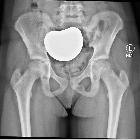ischiopubic synchondrosis asymmetry










Ischiopubic synchondrosis asymmetry (also known as van Neck-Odelberg disease) is characteristic enlargement of one of the ischiopubic synchondroses. It is largely considered an anatomic variant of skeletal developmental, given that it is a common and usually asymptomatic finding.
However, some cases are thought to be symptomatic and may correspond to MR findings that suggest a stress reaction .
Epidemiology
Occurs in all children before puberty during fusion of the pubic and ischial bones .
Clinical presentation
Most cases of ischiopubic synchondrosis asymmetry are observed in asymptomatic patients. Symptomatic cases are described as presenting with groin or buttock pain in ambulatory, pre-pubertal children
Pathology
Ischiopubic synchondrosis asymmetry is much more common on the side of the weight-bearing non-dominant foot, with the differences in ossification thought to result from asymmetric mechanical forces .
Radiographic features
Recognition of an entity as a normal variant is important for radiologists when interpreting a pediatric pelvic radiograph. One of the key questions to ascertain is whether the region is painful or not:
- if asymptomatic and there is no concerning antecedent history: it is unlikely to represent a sinister pathology other than just a developmental variant
- if symptomatic or if the there is concerning antecedent history: it could still be a developmental variant although other important differential considerations should also be considered
Ischiopubic synchondrosis can be avid on bone scintigraphy and FDG PET/CT.
Differential diagnosis
On imaging alone, the condition can mimic many other pathological entities including:
- stress fracture
- osteomyelitis: ischiopubic osteomyelitis
- post-traumatic osteolysis
- bone tumor
The preceding clinical history is crucial in image interpretation.
History and etymology
The condition is named after M van Neck and A Odelberg who initially described these findings in 1924 .
Siehe auch:
und weiter:

 Assoziationen und Differentialdiagnosen zu Morbus van Neck:
Assoziationen und Differentialdiagnosen zu Morbus van Neck:


